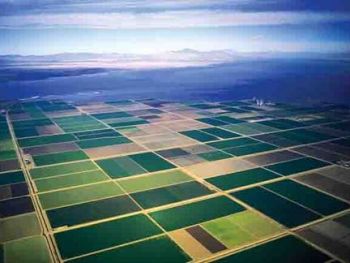Irrigation: Difference between revisions
From ASDSO Dam Safety Toolbox
No edit summary |
No edit summary |
||
| (3 intermediate revisions by 2 users not shown) | |||
| Line 1: | Line 1: | ||
__NOTOC__ | __NOTOC__ | ||
[[Category:Purposes]] | |||
---- | ---- | ||
| Line 11: | Line 12: | ||
|caption= | |caption= | ||
Irrigation from dams and related infrastructure has made desert agriculture feasible ([https://en.wikipedia.org/wiki/Desert_farming Wikipedia]) | Irrigation from dams and related infrastructure has made desert agriculture feasible | ||
(Image Source: [https://en.wikipedia.org/wiki/Desert_farming Wikipedia]) | |||
}} | }} | ||
Ten percent of American cropland is irrigated using water stored behind dams. Dams can be used to both store water and divert it to where it is needed for crops or livestock. Water captured and stored during the winter and spring | Ten percent of American cropland is irrigated using water stored behind dams. Dams can be used to both store water and divert it to where it is needed for crops or livestock. Water is captured and stored during the winter and spring when most watersheds experience the most amount of [[precipitation]]. The stored water can be released during the summer and fall months when precipitation is less frequent, prolonging the growing season and increasing agricultural output in a given year. | ||
Some guidance for these [[Types of Dams|types of dams]] can be found at: | |||
USDA Irrigation Reservoir Code | |||
https://www.nrcs.usda.gov/sites/default/files/2022-09/Irrigation_Reservoir_436_CPS_9_2020.pdf | |||
<!-- Revision history information --> | <!-- Revision history information --> | ||
{{revhistinf}} | {{revhistinf}} | ||
Latest revision as of 02:32, 28 February 2024

|
| Irrigation from dams and related infrastructure has made desert agriculture feasible
(Image Source: Wikipedia) |
Ten percent of American cropland is irrigated using water stored behind dams. Dams can be used to both store water and divert it to where it is needed for crops or livestock. Water is captured and stored during the winter and spring when most watersheds experience the most amount of precipitation. The stored water can be released during the summer and fall months when precipitation is less frequent, prolonging the growing season and increasing agricultural output in a given year.
Some guidance for these types of dams can be found at:
USDA Irrigation Reservoir Code https://www.nrcs.usda.gov/sites/default/files/2022-09/Irrigation_Reservoir_436_CPS_9_2020.pdf
Revision ID: 7813
Revision Date: 02/28/2024
